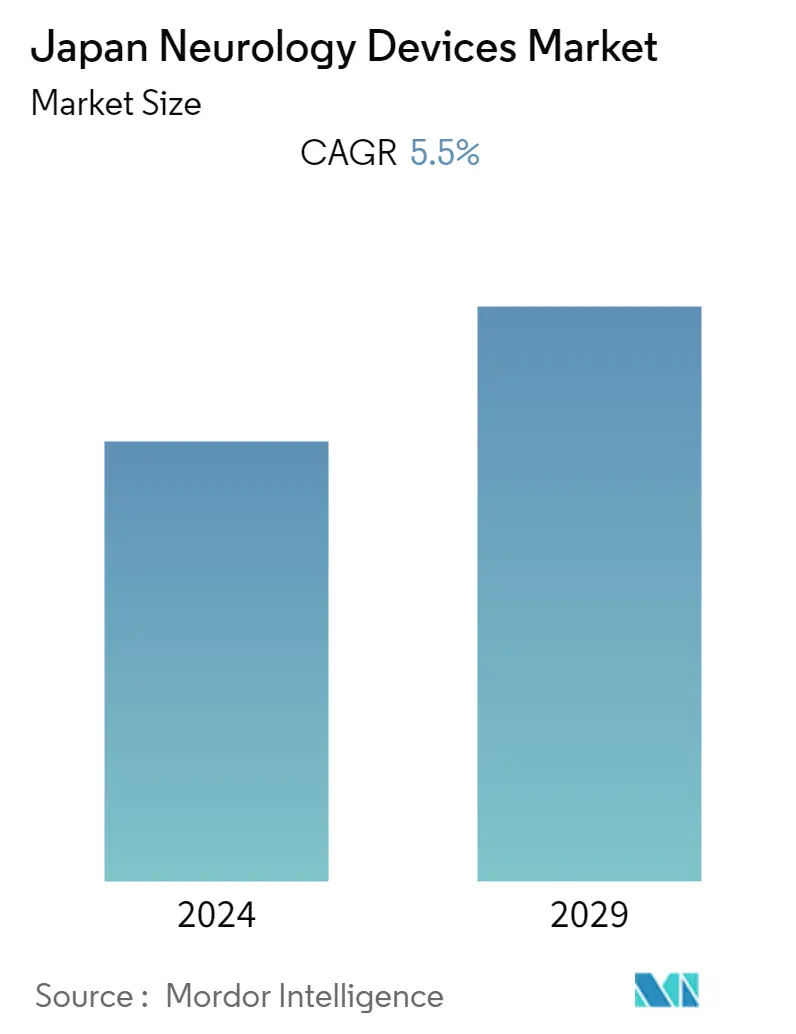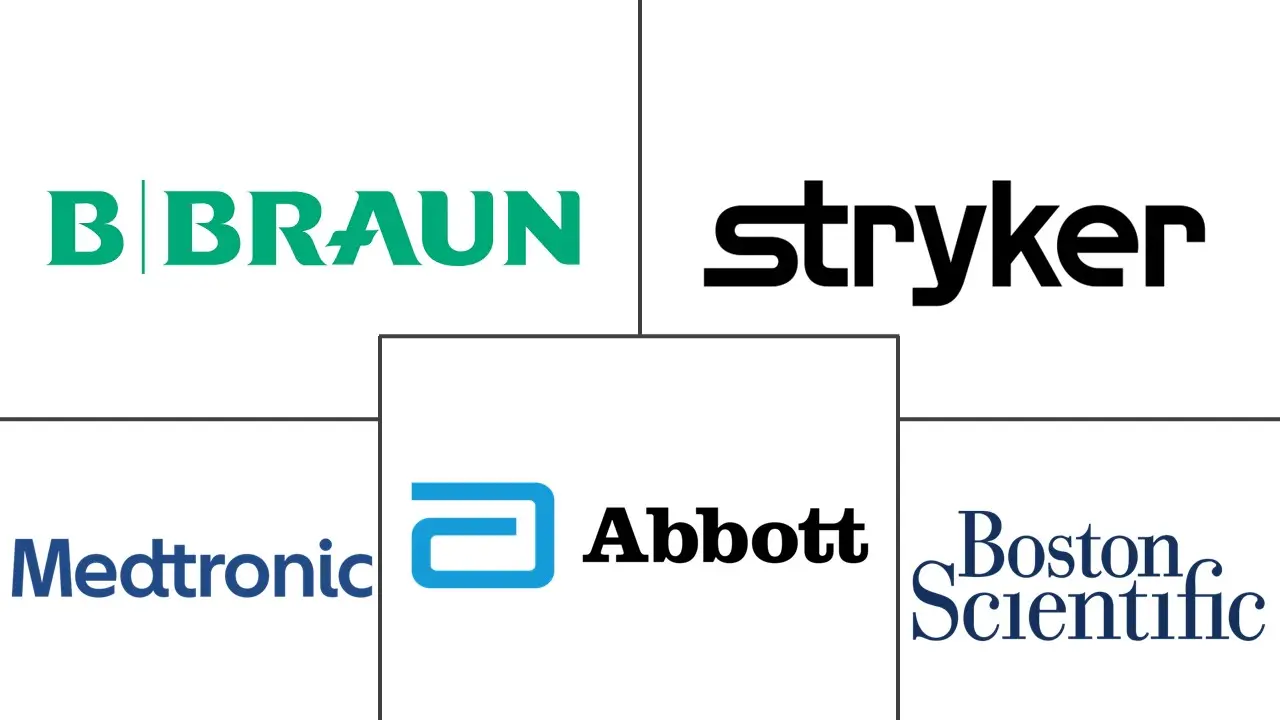Market Size of Japan Neurology Devices Industry

| Study Period | 2019 - 2029 |
| Base Year For Estimation | 2023 |
| Forecast Data Period | 2024 - 2029 |
| Historical Data Period | 2019 - 2022 |
| CAGR | 5.50 % |
| Market Concentration | Medium |
Major Players
*Disclaimer: Major Players sorted in no particular order |
Japan Neurology Devices Market Analysis
The Japan Neurology Devices Market is expected to grow at a CAGR of 5.5% during the forecasted period.
COVID-19 had a significant impact on the Japanese neurology devices market and the overall healthcare industry. According to the study published in Spine Surgery and Related Research in February 2022, the initial COVID-19 semi-lockdown in Japan resulted in fewer elective surgeries and more urgent surgeries that had affected progressive neurological deterioration for some spine patients, even in a nonepidemic region. Moreover, according to the study published in Surgery Today in November 2022, during the COVID-19 pandemic, overall, fewer surgeries were performed, and the rate of decline was about 10% to 15%. Hence, COVID-19 had a significant impact on the Japanese neurology devices market in the initial phase of the pandemic. However, currently, the market is growing at a stable pace owing to a resumption of neurological surgeries, diagnosis procedures, a resumption of manufacturing activities, and the widespread availability of products across Japan, and it is expected to witness a similar trend over the coming years.
The key factors propelling the growth of this market are an increase in the incidence of neurological disorders, huge investments by private players in neurology devices, and an increase in R&D in the field of neuro therapies. For instance, according to the study published in the Journal of Alzheimer's Diseases in March 2021 in Japan, it was predicted that there will be between 6.5 million to 7 million and 8.5 million to 11.5 million people with dementia in 2025 and 2060, respectively. Likewise, in Japan, 50-75% of dementia cases are caused by Alzheimer's disease (ADD). In addition, according to the World Alzheimer Report 2022, about 43% of those with mild dementia, 67% of those with moderate dementia, and 90% of those with severe dementia were institutionalized in the country. Thus, a significant burden of neurological diseases is expected to boost demand for neurology devices, thereby boosting the market's growth.
Furthermore, increased investment by the market players in introducing advanced neurological devices is expected to boost the market over the forecast period. For instance, in January 2022, GrayMatters Health (GMH), a developer of digital self-neuromodulation therapeutics for mental disorders, announced the successful closing of its USD 10 million Series A financing round. Otsuka Medical Devices Co., Ltd. (Tokyo, Japan) was the lead investor in this round. With the funding, GrayMatters will introduce the first digital therapeutic device that directly targets and regulates specific brain biomarkers associated with mental disorders.
Thus, all the aforementioned factors, such as the significant burden of neurological diseases and investments in neurology devices, are expected to boost market growth in the near future. However, the high cost of equipment may restrain market growth over the forecast period.
Japan Neurology Devices Industry Segmentation
As per the scope of the report, neurological devices are medical devices that help to diagnose, prevent, and treat a variety of neurological disorders and conditions, such as Alzheimer's disease, Parkinson's disease, major depression, and traumatic brain injury. The Japan Neurology Devices Market is Segmented by Type of Device (Cerebrospinal Fluid Management Device, Interventional Neurology Device (Interventional/Surgical Simulators, Neurothrombectomy Devices, and Carotid Artery Stents, and Others), Neurosurgery Devices (Neuroendoscopes, Stereotactic Systems, and Other Neurosurgery Devices), Neurostimulation Device (Spinal Cord Stimulation Devices, Deep Brain Stimulation Devices, Sacral Nerve Stimulation Devices, and Other Neurostimulation Devices), and Other Type of Devices). The report offers the value (in USD million) for the above segments.
| By Type of Device | ||||||
| Cerebrospinal Fluid Management Devices | ||||||
| ||||||
| ||||||
| ||||||
| Other Types of Devices |
Japan Neurology Devices Market Size Summary
The Japan neurology devices market is poised for growth, driven by an increasing incidence of neurological disorders and significant investments in research and development within the field. The market experienced initial disruptions due to the COVID-19 pandemic, which led to a decrease in elective surgeries and a shift towards urgent procedures, impacting the progression of neurological conditions. However, the market has since stabilized, with a resurgence in neurological surgeries and diagnostic procedures, alongside resumed manufacturing activities and product availability. The demand for neurology devices is further bolstered by the rising prevalence of conditions such as Alzheimer's disease and Parkinson's disease, which are expected to increase the need for advanced treatment solutions.
Investment in innovative neurological devices is a key factor contributing to market expansion, with companies like GrayMatters Health securing substantial funding to develop digital therapeutics targeting brain biomarkers. The growing geriatric population in Japan, coupled with the high life expectancy, is also driving the demand for cerebrospinal fluid management devices and deep brain stimulation technologies. These devices are crucial in managing conditions prevalent among the elderly, such as traumatic brain injuries and movement disorders. The competitive landscape of the market includes both regional and global players, with companies like B. Braun Melsungen AG, Stryker Corporation, and Medtronic PLC playing significant roles. Recent partnerships and product launches, such as those by Shionogi & Co., Ltd. and Terumo Corporation, highlight ongoing efforts to advance treatment options and stimulate market growth.
Japan Neurology Devices Market Size - Table of Contents
-
1. MARKET DYNAMICS
-
1.1 Market Overview
-
1.2 Market Drivers
-
1.2.1 Increase in Incidence of Neurological Disorders
-
1.2.2 Huge Investments by Private Players in Neurology Devices
-
1.2.3 Increase in R&D in the Field of Neurotherapies
-
-
1.3 Market Restraints
-
1.3.1 High Cost of Equipment
-
1.3.2 Stringent FDA Validation and Guidelines for New Devices
-
-
1.4 Porter Five Forces
-
1.4.1 Threat of New Entrants
-
1.4.2 Bargaining Power of Buyers/Consumers
-
1.4.3 Bargaining Power of Suppliers
-
1.4.4 Threat of Substitute Products
-
1.4.5 Intensity of Competitive Rivalry
-
-
-
2. MARKET SEGMENTATION (Market Size by Value - USD Million)
-
2.1 By Type of Device
-
2.1.1 Cerebrospinal Fluid Management Devices
-
2.1.2 Interventional Neurology Devices
-
2.1.2.1 Interventional/Surgical Simulators
-
2.1.2.2 Neurothrombectomy Devices
-
2.1.2.3 Carotid Artery Stents
-
2.1.2.4 Others
-
-
2.1.3 Neurosurgery Devices
-
2.1.3.1 Neuroendoscopes
-
2.1.3.2 Stereotactic Systems
-
2.1.3.3 Other Neurosurgery Devices
-
-
2.1.4 Neurostimulation Devices
-
2.1.4.1 Spinal Cord Stimulation Devices
-
2.1.4.2 Deep Brain Stimulation Devices
-
2.1.4.3 Sacral Nerve Stimulation Devices
-
2.1.4.4 Other Neurostimulation Devices
-
-
2.1.5 Other Types of Devices
-
-
Japan Neurology Devices Market Size FAQs
What is the current Japan Neurology Devices Market size?
The Japan Neurology Devices Market is projected to register a CAGR of 5.5% during the forecast period (2024-2029)
Who are the key players in Japan Neurology Devices Market?
B. Braun Melsungen AG, Stryker Corporation, Boston Scientific Corporation, Medtronic PLC and Abbott Laboratories are the major companies operating in the Japan Neurology Devices Market.

